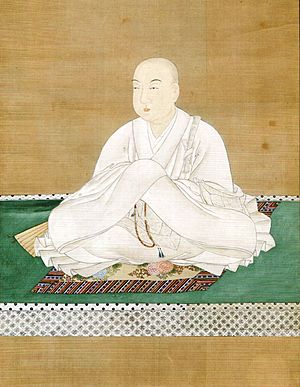Emperor Seiwa facts for kids
Quick facts for kids Emperor Seiwa清和天皇 |
|||||
|---|---|---|---|---|---|
 |
|||||
| Emperor of Japan | |||||
| Reign | October 7, 858 – December 18, 876 | ||||
| Coronation | December 15, 858 | ||||
| Predecessor | Montoku | ||||
| Successor | Yōzei | ||||
| Born | May 10, 850 Heian Kyō (Kyōto) |
||||
| Died | January 7, 881 (aged 30) Heian Kyō (Kyōto) |
||||
| Burial | Minooyama no misasagi (水尾山陵) (Kyoto) | ||||
| Spouse | Fujiwara no Takaiko (among others) |
||||
| Issue Among others... |
Emperor Yōzei | ||||
|
|||||
| House | Yamato | ||||
| Father | Emperor Montoku | ||||
| Mother | Fujiwara no Akirakeiko | ||||
Emperor Seiwa (清和天皇, Seiwa-tennō, May 10, 850 – January 7, 881) was the 56th emperor of Japan. He ruled from 858 to 876.
Contents
Seiwa's Early Life
Seiwa was the fourth son of Emperor Montoku. His mother was Empress Dowager Fujiwara no Akirakeiko. She was also known as the Somedono empress. Seiwa's mother was the daughter of Fujiwara no Yoshifusa, who was a very powerful leader. Yoshifusa served as a regent, meaning he ruled for the emperor when the emperor was too young or unable to rule. He was also a great minister in the government.
Seiwa had an older half-brother named Imperial Prince Koretaka (844–897).
What's in a Name? Seiwa's Personal Name
Before Seiwa became emperor, his personal name was Korehito (惟仁). He was the first member of the Imperial House of Japan to have a personal name ending with "-hito" (仁). This character, "仁," means "kindness" or "humanity" in Confucianism. Since Seiwa's time, it has become a tradition for all male members of the Imperial family to have names ending this way.
Emperor Seiwa was also sometimes called Mizunoo-no-mikado or Minoo-tei.
Key Moments in Seiwa's Reign
Seiwa was first looked after by his mother's father, Fujiwara no Yoshifusa. Yoshifusa helped Seiwa become the Crown Prince, even though his older half-brother, Prince Koretaka, was originally expected to take the role.
When his father, Emperor Montoku, passed away in 858, Seiwa became emperor at just 9 years old. However, his grandfather, Yoshifusa, held the real power as regent.
Here are some important events from Seiwa's life:
- October 7, 858: Emperor Montoku died. His son, Seiwa, became the new emperor.
- December 15, 858: The 9-year-old emperor officially announced his enthronement. His grandfather, Yoshifusa, was named regent. This was the first time a member of the Fujiwara family held this high position. It was also the first time in Japan that a very young child became emperor.
- 859: All New Year's celebrations were canceled because the country was mourning the death of Emperor Montoku.
- 859: Construction started on the Iwashimizu Shrine near Heian-kyō (which is now Kyoto). This shrine honors Hachiman, who is known as the Shinto god of war.
- 869: Seiwa's son, Yōzei, was born. He was named Seiwa's heir the next year.
- 876: Emperor Seiwa gave up his throne to his five-year-old son, Yōzei. This meant Yōzei became the new emperor.
- 878: Seiwa decided to become a Buddhist priest. His new name as a priest was Soshin.
- January 7, 881: Former-Emperor Seiwa passed away when he was 30 years old.
Seiwa's Burial Place
The exact location of Seiwa's grave is known. The emperor is traditionally honored at a special Shinto shrine called a misasagi in the Ukyō-ku area of Kyoto. The Imperial Household Agency officially calls this place Seiwa's mausoleum. Its formal name is the Minooyama no Misasagi (清和天皇陵) or Seiwa Tennō Ryō. Because of his tomb's location, Emperor Seiwa is sometimes called the Emperor Mizunoo (水尾帝, Mizunoo-tei). The kami (spirit) of Emperor Seiwa is honored at the Seiwatennō-sha shrine, which is very close to his mausoleum.
Important Officials During Seiwa's Reign
The Kugyō (公卿) was a special group of the most powerful men who worked for the Emperor of Japan before the Meiji period. This group usually had only three or four men at a time. They were born into important families and had a lot of experience in government.
During Emperor Seiwa's reign, some of the top officials included:
- Sesshō (Regent): Fujiwara no Yoshifusa
- Daijō-daijin (Chancellor of the Realm): Fujiwara no Yoshifusa
- Sadaijin (Minister of the Left): Minamoto no Makoto and Minamoto no Tooru
- Udaijin (Minister of the Right): Fujiwara no Yoshimi, Fujiwara no Ujimune, and Fujiwara no Mototsune
- Dainagon (Chief Counselor): Fujiwara no Mototsune
Eras of Seiwa's Reign
The years of Emperor Seiwa's rule are known by specific era names or nengō. These eras help mark different periods in Japanese history.
Seiwa's Family
Emperor Seiwa had many consorts (wives) and children. His most important consort was Fujiwara no Takako, who later became Kōtaigō (Empress Dowager).
Some of his notable children included:
- His first son, Imperial Prince Sadaakira, who later became Emperor Yōzei.
- Imperial Prince Sadasumi (873–916), who was the father of Minamoto no Tsunemoto. Minamoto no Tsunemoto founded the Seiwa Genji family, from which important military governments like the Kamakura shogunate, Ashikaga shogunate, and Tokugawa shogunate later came.
Images for kids
See also
 In Spanish: Seiwa Tennō para niños
In Spanish: Seiwa Tennō para niños
- Emperor of Japan
- List of Emperors of Japan
- Gion Matsuri – A famous festival in Kyoto, said to have started during Emperor Seiwa's reign.
| Regnal titles | ||
|---|---|---|
| Preceded by Emperor Montoku |
Emperor of Japan: Seiwa 858–876 |
Succeeded by Emperor Yōzei |


